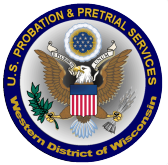Supervision occurs after the supervisee has pled guilty or been tried and found guilty and after they have been released from incarceration.
The Court may sentence a supervisee to probation or to a term of incarceration followed by a term of supervised release. Probation is a court ordered sentence issued as an alternative to jail or prison. Individuals under supervision (probation or supervised release) are assigned to a probation officer who is responsible for monitoring them and ensuring they comply with the conditions ordered by the Court and obey laws.
Supervision in the federal system is:
- A core responsibility of U.S. probation and pretrial services officers, along with investigation.
- A way to monitor the activities and behavior of people released to the community by the federal courts or paroling authorities.
- An opportunity to help the supervisee reintegrate into the community.
- In the case of probation, a punishment that is less severe than imprisonment, but still holds people accountable for breaking the law.
- An alternative to jail or prison that costs less than incarceration and gives people charged with or convicted of federal crimes the opportunity to live with their families, hold jobs, and be productive members of society.
Conditions of Supervised Release
At the start of a term of supervision, a probation officer will fully explain the conditions of release to the supervisee. These conditions include the mandatory conditions of release which the Court imposes on all supervisees, and may include discretionary conditions which the Court imposes to provide probation officers with the authority to address risk related issues specific to a particular supervisee. Discretionary conditions may include, among other things, home detention, substance abuse testing or treatment, mental health treatment, and the disclosure of financial information.
Process of Supervision
The process of supervising begins with a probation officer evaluating the supervisee through an interview and risk assessment tool, which allows the officer to identify factors that must be taken into account in developing the supervisee’s individualized supervision plan. From the start and throughout supervision, the officer will assess and reassess the potential risk that the supervisee poses to another person or the community, and address the supervisee's other needs. Continued assessments allow the probation officer to adjust his or her personal contact and interventions with the supervisee accordingly. The supervision plan developed by the officer will address any obstacles (among other things) that may impede a supervisee’s ability or desire to complete supervision successfully. Supervision is also designed to provide services, such as substance abuse and mental health treatment, that the supervisee may require.
